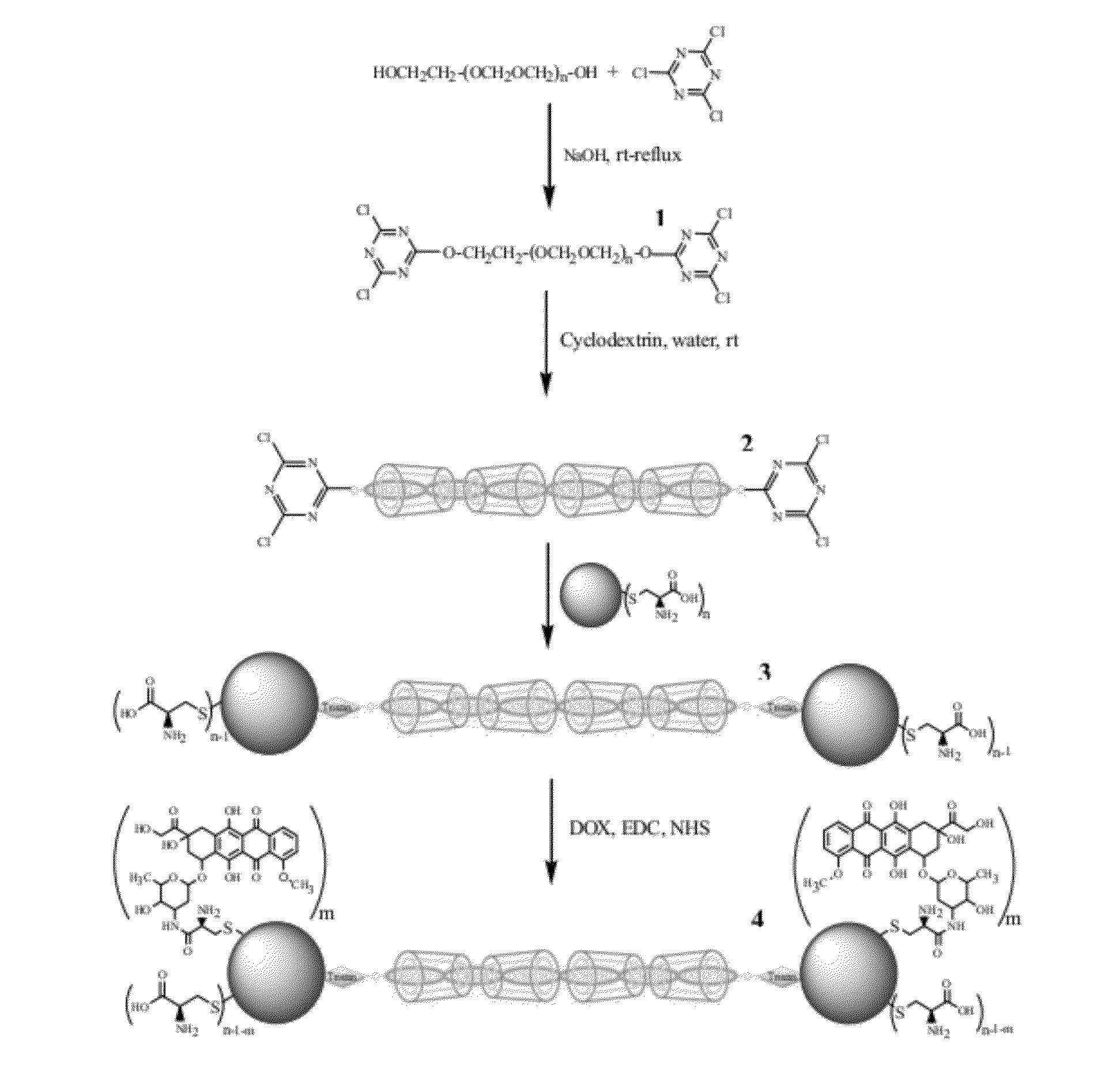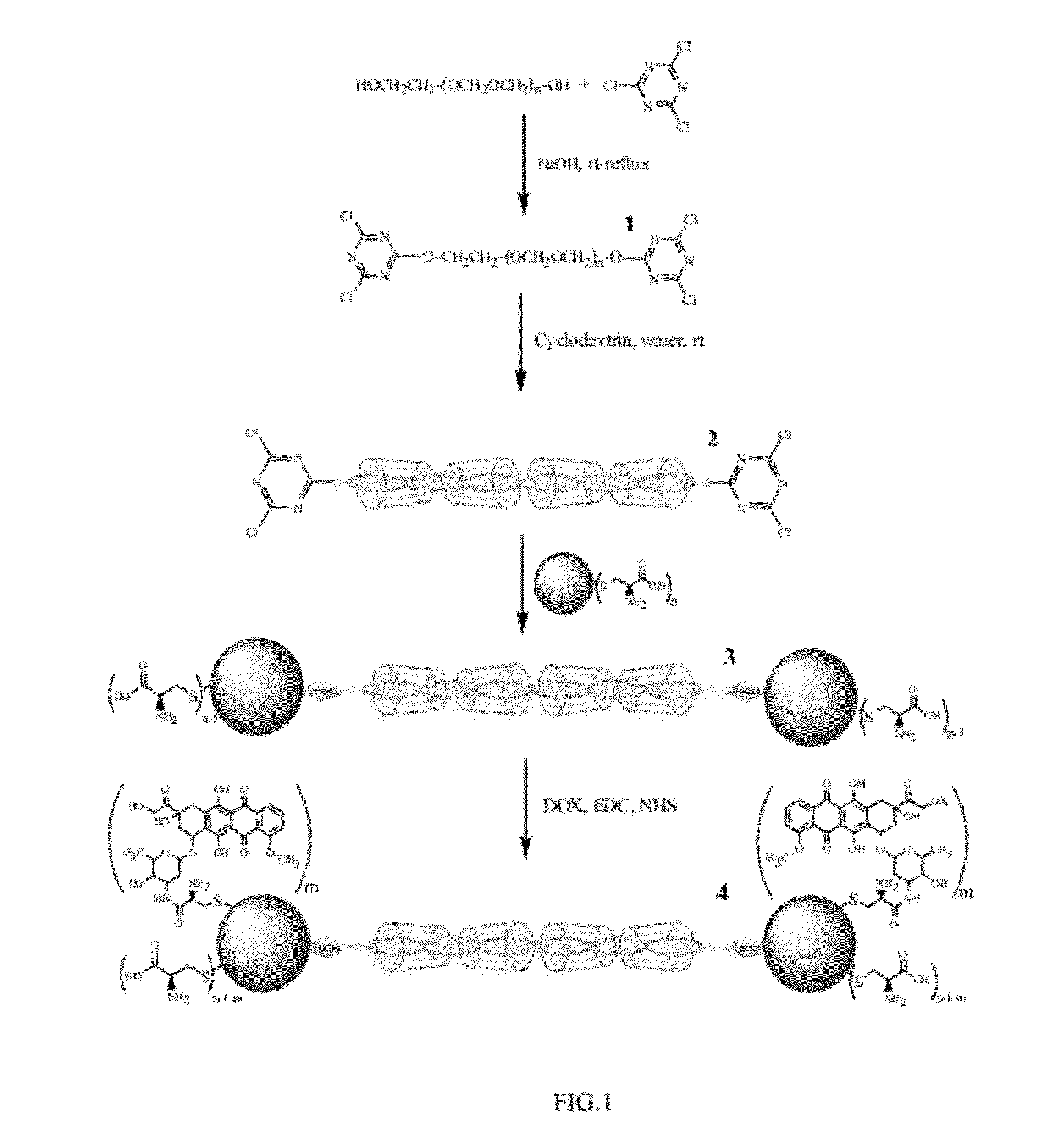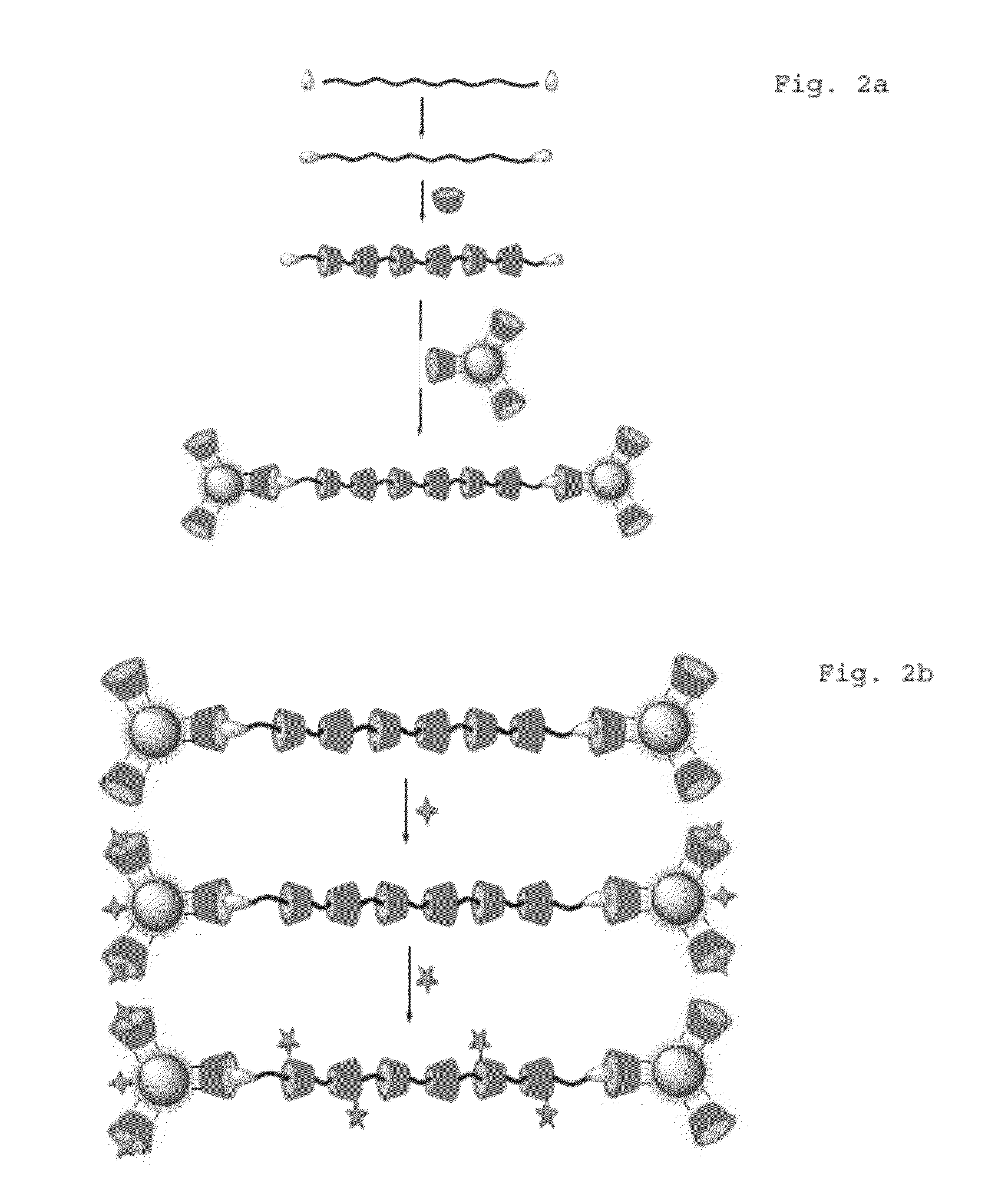Hybrid nanomaterials consisting of pseudorotaxanes, pseudopolyrotaxanes, rotaxanes, polyrotaxanes, nanoparticles and quantum dots
a technology of hybrid nanomaterials and nanoparticles, applied in the direction of biocide, plant growth regulators, pharmaceutical non-active ingredients, etc., can solve the problems of some disadvantages of hybrid nanomaterials, and achieve the effect of reducing the number of applications
- Summary
- Abstract
- Description
- Claims
- Application Information
AI Technical Summary
Benefits of technology
Problems solved by technology
Method used
Image
Examples
example 1
Production of Cyclodextrin-Polyrotaxane End-Capped by Quantum Dots With Cysteine Capping Agent (PR-Cys-CdSe QDs)
[0104]Typically a solution of poly(ethylene glycol) (MW=1000), PEG, (9 g, 9×10−3 mol) and sodium hydroxide (0.64 g, 16×10−3 mol, in 5 ml water) was added dropwise to a solution of cyanuric chloride (13 g, 7×10−2 mol, in 150 ml dichloromethane) and stirred at 0-40° C. for 1 h and then refluxed for 6 h. The mixture was then filtered and solvent was evaporated and obtained solid compound was dissolved in diethyl ether. The solution was filtered and precipitated in an ice bath. The precipitate was dissolved in dichloromethane, filtered and solvent was evaporated to obtain functionalized polyethylene glycol (Cl-PEG-C1) as colorless oil [39].
[0105]Then Cl-PEG-Cl (1 gr, 0.77 mmol) was dissolved in 2 ml distilled water and added to a reaction flask containing a suspension of α-CD in distilled water (3.75 gr, 3.85 mmol, in 2 ml distilled water) with vigorous stirring at 25° C. The ...
example 2
[0110]Production of cyclodextrin-polyrotaxane end-capped by quantum dots with beta-cyclodextrin (β-CD) and mercaptoacetic acid (MAA) capping agents (PR-CD / MAA-CdSe QDs): PR-CD / MAA-CdSe QDs was prepared in the same manner as explained in Example 1 except that quantum dots with beta-cyclodextrin and mercaptoacetic acid capping agents (CD / MAA-CdSe QDs), see below for the preparation strategy, was used instead of the Cys-CdSe QD. 1H NMR (400 MHz, D2O) δ 2.75-5 (Protons both CD / MAA-CdSe QDs and Ps-PR). IR (cm−1, KBr): 1000-1300 (asymmetric glycosidic vibrations of pseudopolyrotaxane backbone), 1581.52 (CO2), 2952 (C—H), 3375 (OH).
[0111]CD / MAA-CdSe QDs was prepared as follows:
[0112]For preparation of CdSe QDs containing both MAA and CD capping agents, CdCl2.H2O (0.6840 g, 3.4 mmol) was dissolved in 50 ml distilled water at room temperature. Upon addition of MAA (0.3 ml, 4.31 mmol) to this solution, white colloids appeared. Then HS-β-CD [40] (0.025 g, 2 mmol) was added to this mixture and ...
example 3
Conjugation of DOX to PR-Cys-CdSe QDs (DOX-PR-Cys-CdSe QDs)
[0114]EDC (0.0004 g, 0.002 mmol), NHS (0.00023 g, 0.002 mmol) and DOX (0.0015 g, 0.0027 mmol) were added to a 100 ml 3-neck round-bottom flask containing 5 ml distilled water and pH of solution was adjusted at 7.4 and mixture was stirred at room temperature for 30 minutes. Then a solution of PR-Cys-CdSe QDs (0.01 g in 20 ml distilled water) was added to above mixture at 25° C. The mixture was stirred for 6 h at 25° C. and then dialyzed against water (1 h) to obtain the final product. IR (cm−1, KBr): 1031 (C—OH), 1151 (C—O—C), 1647(amide bond), 2923 (C—H), 3344 (O—H).
PUM
| Property | Measurement | Unit |
|---|---|---|
| Biocompatibility | aaaaa | aaaaa |
| Interaction | aaaaa | aaaaa |
| Thermal properties | aaaaa | aaaaa |
Abstract
Description
Claims
Application Information
 Login to View More
Login to View More - R&D
- Intellectual Property
- Life Sciences
- Materials
- Tech Scout
- Unparalleled Data Quality
- Higher Quality Content
- 60% Fewer Hallucinations
Browse by: Latest US Patents, China's latest patents, Technical Efficacy Thesaurus, Application Domain, Technology Topic, Popular Technical Reports.
© 2025 PatSnap. All rights reserved.Legal|Privacy policy|Modern Slavery Act Transparency Statement|Sitemap|About US| Contact US: help@patsnap.com



